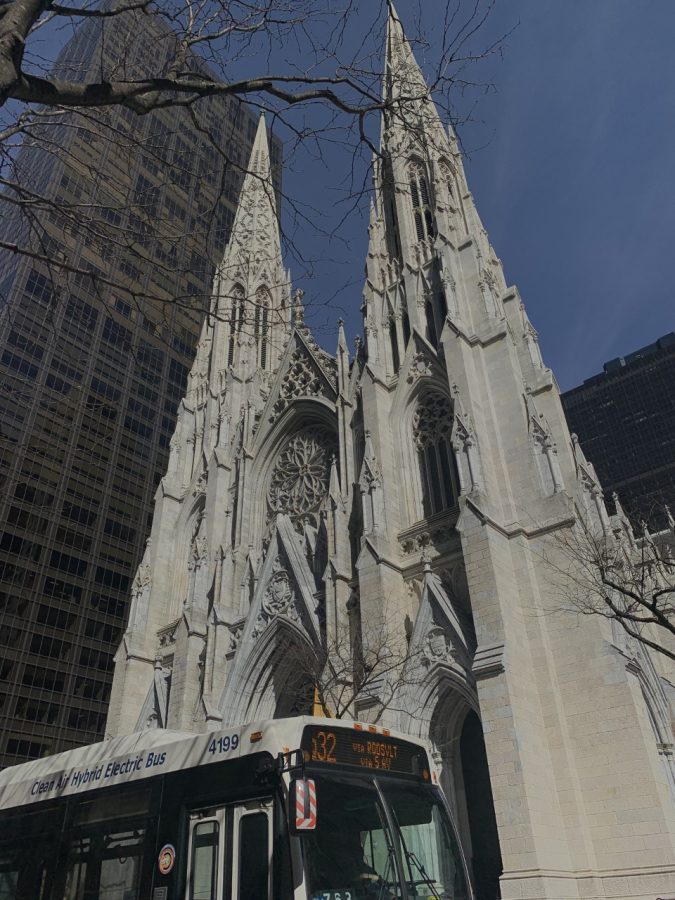New York City’s history
St. Patrick's Cathedral's beautiful architecture contrasts greatly against the bustling New York City view.
- St. Patrick’s Cathedral– This stunning cathedral was laid in New York City, New York in 1858, and opened in 1879. Saint Patrick, for whom this church is named along with many others around the world, was closely linked with Ireland. He helped spread Catholicism all throughout the country until his death. Sermons at this church are performed by His Eminence, Timothy Cardinal Dolan, spreading the word every week to up to 2,400 guests.
- Brooklyn Bridge– This bridge, completed in 1833, was designed by John A. Roebling, connecting Lower Manhattan and Brooklyn Heights. The bridge is approximately 6,016 feet and carries over 100,000 vehicles and 30,000 people over the East River each day. It was named a historical landmark in 1869 and remains a popular tourist attraction and viable commute path for thousands each day.
- Monument Park at the Yankees Stadium– The first monument that started this small park in Yankees Stadium was dedicated to Miller Higgens in 1932, a manager. There are large granite blocks dedicated to six Yankees: Miller Higgens, Lou Gehrig, Babe Ruth, Mickey Mantle, Joe DiMaggio, and owner George Steinbrenner. This park is open to tourists and ticketholders there for baseball games.
- The Strand Bookstore– Opening its doors in 1927, on what was originally called Book Row, Ben Bass started this store with about $600, and a determination to create a place for books to be cherished. Now, the storehouses over 2.5 million books, with the books sectioned off into specific genres, spread out over four floors.
- The Museum of Natural History– This grand educational establishment was founded in 1869, and aims to “ discover, interpret, and disseminate—through scientific research and education—knowledge about human cultures, the natural world, and the universe.” The museum also has a college affiliated with it, that offers science-based Ph.D. and Master’s programs.
- New York Subway Station-The Metropolitan Transportation Authority is the largest transportation system in North America, with subway tracks over 5,000 square miles of the state of New York. The first subway was built in Manhattan, in 1904, and has expanded greatly since. The subway operated 24-7, serving as a main form of transportation, as many New Yorkers typically don’t like the chaotic streets above.
- Ellis Island National Museum of Immigration– Adjacent to the Statue of Liberty, Ellis Island is often stopped either before or after tourists visit the statue. This island houses the historical immigration center, where, from the 1890s to 1954, the center saw thousands of immigrants from all over the world aiming to enter New York every day. In order for them to be admitted, they had to pass through the center, where they were examined, processed for Visas, and either confirmed entry or denied. You can see the hall where people flocked, dormitories, and even read about life on the island, which was not as appealing as they had thought it would be.
- Alexander Hamilton’s Grave at Trinity Church– The famed Alexander Hamilton is laid to rest in the cemetery of Trinity Church, He passed away from his injuries from a duel on July 12, 1804, at the hands of Aaron Burr. Throughout his life, he worked closely with President George Washington and worked to lay the foundation for America’s economy. He was a member of the constitutional congress for 11 years and helped co-author the Federalist Papers.
- New York City from Top of the Rock– Located at the top of the Rockefeller Plaza, guests are able to travel 848 feet by elevator and experience a 360-degree view of New York City. Jimmy Fallon’s television show, “The Tonight Show” takes place in the building beneath. This experience is popular among tourists, as it provides a history and tour of the building, and lets them experience the magnificence of New York City from 70 stories up.






